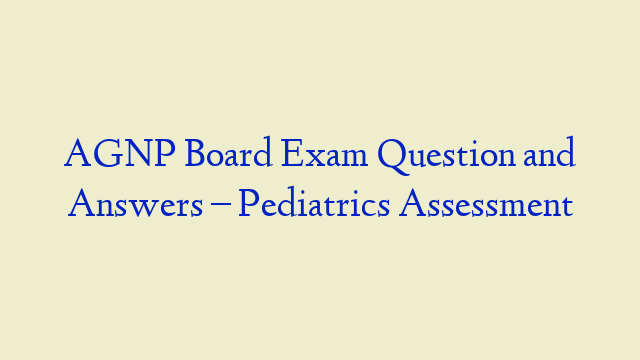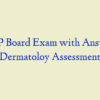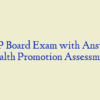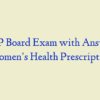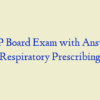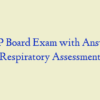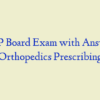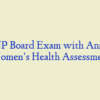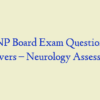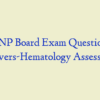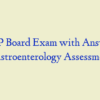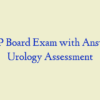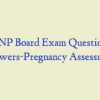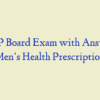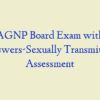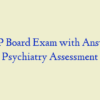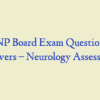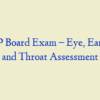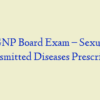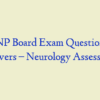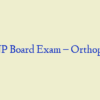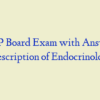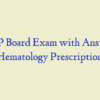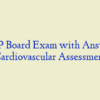Description
AGNP BOARD EXAM QUESTIONS Pediatrics Assessment (127 Questions)
- A child sustained a “full-thickness” burn injury. This type injury involves tissue destruction down to the:
- A child was involved in a vehicular accident and sustained burns on the lower extremities. Examination reveals a dry, waxy, whitish appearance of both lower legs and some visualization of the tibialis anterior. This type of burn would be classified as a:
- The earliest recognizable clinical manifestation(s) of cystic fibrosis in an infant is:
- An infant presents with a rash in the diaper area. Which description likely indicates candidal diaper rash?
- Examination of a child who experienced a burn from a curling iron on the forearm appears red without blistering but is painful to touch. This type of burn would be classified as a:
- A small child sustained burns to the posterior trunk and posterior surface of both arms. According to the “Rule of Nines” for small children, what percentage of the total body surface area was involved?
- If a newborn is suspected of having congenital hypothyroidism, which clinical manifestation would be evident?
- A child has a maculopapular, blotchy rash and on examination of his mouth, red eruptions with white centers on the buccal mucosa are visualized. These eruptions are called:
- When suspecting pediculosis capitis, the chief complaint is:
- A reddish blue, irregularly shaped, solid and spongy mass of blood vessels that may be present at birth and enlarge during the first 10 to 15 months is characteristic of a:
- The infant with the lowest risk of developing elevated levels of bilirubin is the one who:
- A seven- year -old is suspected of having conduct disorder. Which one of the following topics should the nurse practitioner include in the assessment history?
- With Duchenne muscular dystrophy:
- Which of the following would help a 9-year-old develop a sense of industry?
- When assessing a 3-year-old African American child, the most likely cause of black, dusky mucous membranes is related to:
- The first sign of puberty in a male is:
- After attempting to elicit the Moro reflex in a newborn, the nurse practitioner identifies absence of movement of the left arm. The next assessment would be to:
- A 6-month-old presents today for a well child visit. He is sitting in his mother’s lap. Assessment should begin with:
- In which of the following situations would a one-year-old child be at risk for lead poisoning?
- During the newborn’s physical assessment of the mouth, the soft and hard palates are palpated to detect:
- An eight-year-old complains of itching in the right ear and an increase in pain when the pinna is pulled or the tragus is palpated. Examination reveals slight redness in the ear canal with a clear odorless fluid. This could be suggestive of:
- An otherwise healthy two-year-old presents with a heart rate that varies with inspiration and expiration. Which statement is true?
- The nurse practitioner differentiates physiologic jaundice from pathologic jaundice by assessment of the:
- A six-year-old child presents with sore throat, difficulty swallowing, and a temperature of 102 °F. Findings reveal lymphadenopathy and pharyngeal erythema. This is probably:
- When a child presents with a history of a head injury sustained within the past four hours, a subdural hematoma should be expected because:
- Symptoms of acrocyanosis in the newborn include:
- A 9 year old girl had a history of tuberculosis when she was 6 years old. She presents with recent weight loss and anorexia. Along with her presenting symptoms, which one of the following assessment findings would be most indicative of Addison’s disease?
- A child received a burn to the chest from a cup of hot coffee. On examination, the injured area appears moist and red to ivory white in color, blisters are noted, and painful to touch. This burn would be classified as a:
- When assessing a normal 5-year-old, the last site to assess would be the:
- Which developmental area is predominantly affected by lead poisoning?
- A teenage complains of itching and burning of his eye. Examination reveals an erythematous eyelid margin with crusting and a clear mucus discharge. These findings are consistent with:
- Which one of the following would be an abnormal finding in a 6-month-old?
- Symptoms indicative of Shaken Baby Syndrome are related to:
- When assessing a 3-month-old for developmental dysplasia of the hips (DDH), which one of the following symptoms would be suspicious of dysplasia?
- Symptoms of a child suspected of having a diagnosis of mixed failure to thrive (FTT) are usually seen in children:
- At what age would a baby first be expected to locate an object hidden from view?
- A 4-year-old child presents with bilateral watery discharge from the eyes. Examination reveals subconjunctival hemorrhage, and eyelid ecchymosis. These findings are consistent with:
- Children with Legg-Calve Perthes disease should:
- The hemodynamic changes resulting from structural defects in children can lead to heart failure. The most common reason for these changes is related to:
- Which of the following statements made by a parent would alert the nurse practitioner to suspect autism spectrum disorder?
- Presence of a heart murmur in a child would be considered organic if the child:
- Current indications for tympanostomy tube placement include all of the following except which one?
- On examination of a six-week-old infant, developmental hip dysplasia (DDH) is suspected. If DHH is present, it might be evidenced by:
- Why would a newborn with patent ductus arteriosus receive a prostaglandin inhibitor (indomethacin)?
- Which of the following group of symptoms would be suggestive of an infant experiencing a congenital heart defect associated with a decreased pulmonary blood flow pattern?
- Which of the following findings in a preschooler would indicate the need for further evaluation?
- The most common cause of bacterial pharyngeal infections in children is:
- When assessing a preschooler’s mouth, the number of deciduous teeth seen should be:
- Symptoms of bacterial conjunctivitis in an infant include:
- A 9-month-old who has been a healthy, thriving infant presents with a poor appetite, two episodes of vomiting, three bloody stools with mucus and knees drawn to the abdomen with screaming. These are clinical manifestations of:
- Which one of the following statements indicates a developmental delay?
- The four classic structural defects of Tetralogy of Fallot include:
- Which of the following milestones is developmentally appropriate for a 2-month-old infant when pulled to a sitting position?
- An indication that there is a malfunction of a ventriculoperitoneal (VP) shunt in an older child would be the presence of a:
- Which one of the following patient positions would be least beneficial to examine the genitals of a young female child?
- A granulomatous eyelid cyst or nodule that is painless and erythematous is termed:
- An example of a cause of conductive hearing loss in children would be:
- A three-week-old infant presents with a generalized lacy, reticulated blue discoloration of the skin. This is suggestive of:
- Which activity would be most appropriate to promote the growth and development of a 3-year-old boy with hemophilia who is one week post hemarthrosis episode of his left knee?
- A pediatric patient presents with erythema marginatum, chorea, and a heart murmur. These symptoms are consistent with:
- A five year old will engage in what type of play?
- In renal adaptation of the newborn, which one of the following statements is correct?
- A child presents with erythematous papules and vesicles, that are weeping, oozing, and crusty. These lesions are located over the forehead, wrists, elbows, and the backs of the knees. With which of the following conditions are these symptoms associated?
- A child presents with a complaint of a left earache that worsens with head movement. Findings on examination include temperature of 102 °F, cellulitis behind the left ear. These findings are consistent with:
- The mouth of a ten-month-old infant has white patches on the mucosa that cannot be removed. These patches are consistent with:
- To assess for strabismus in a child, use the:
- All of the following symptoms in a 10-month-old would be indicative of acute otitis media (OM)except:
- Which one of the following procedures would confirm a the definitive medical diagnosis of Hirschsprung’s disease?
- Undescended testicle(s) in a young male is termed:
- Children presenting with congenital heart defects that result in right to left shunting would most likely exhibit which of the following symptoms?
- Which one of the following symptoms is seen in infants with pyloric stenosis?
- Children with type 1 diabetes mellitus usually present with which one of the following symptoms?
- Respiratory effort in the neonate is initiated at birth as a result of:
- Anticipatory guidance for the family of a pre-adolescent with a cognitive impairment should include information about:
- Assessing the neurological status of a child with a ventriculoperitoneal shunt should include:
- When examining the scrotum in a young male child, test the cremasteric reflex by:
- When administering ear drops to a 6-year-old, the pinna should be pulled:
- An infant with a suspected hearing loss:
- An 8-month-old with a significant head lag would suggest the need for:
- A normal finding in the musculoskeletal assessment of a 3-year-old child would be the presence of:
- Assessment findings in a newborn at birth include: irregular respirations without crying, heart rate of 105 beats/minute, grimaces with reflex stimulation, kicking of both feet, and moving of both arms. The body and face are pink and hands and feet are cyanotic. What is the APGAR score?
- A six-year-old complains that something is in her left eye. There is a red raised area of the left lid. There is redness and tenderness of the eye and tearing. These findings are consistent with:
- A 3 year-old presents with a history of fever and cough over the past 24 hours. Findings on exam reveal: temperature of 102°F, apical heart rate of 157 beats/minute, and respiratory rate of 40 breaths/minute. Tachypnea in this child is most likely related to
- A six-year-old child presents with a few small vesicles that are honey-colored and weeping around the left nare. These lesions are consistent with:
- Which one of the following groups of symptoms would be more consistent in a child with type 2 diabetes mellitus?
- A twelve-month-old has a history of heart failure related to his congenital heart defect. He is receiving aldactone (Spironolactone), enalapril (Vasotec), furosemide (Lasix), and acetaminophen (Tylenol). The infant’s potassium level is 3.1 meq/l. Which medication is most likely decreasing his potassium level?
- A twelve-month-old was recently diagnosed with Acquired Immunodeficiency Syndrome (AIDS). The mother asks the nurse practitioner: “How could my child have acquired AIDS?” The best response from the nurse practitioner should be that: “Children under two years of age usually acquire AIDS:
- A child presents with fever of 102.5 °F for the past five days. Kawasaki disease is suspected if which of the following groups of symptoms is present?
- A six-year-old has a history of diabetes mellitus type I and is now experiencing cellulitis of the right lower leg. The child presents with deep, rapid, and unlabored respirations, fruity odor, and dry skin. These are symptoms of:
- An infant weighed 8 pounds at birth. According to the principles of normal growth and development, how much should he weigh at 12 months of age?
- Physical exam of a well two-week-old infant reveals a little dimple with a small amount of hair just above the sacral area. This could be:
- A 5-year-old child presents with complaints of fever and headache. Examination reveals a heart rate of 157 beats/minute, respiratory rate of 40 breaths/minute, B/P 108/54, and a temperature of 102.6 °F. The increased heart rate is most likely related to:
- Which one of the following positions is the most accurate regarding infant car seat placement? The car seat should:
- When performing a cardiovascular assessment on a healthy 2-year-old child:
- The parents of a child with sickle cell anemia are asking for information about future pregnancies. The nurse practitioner should respond by telling them that with any future pregnancy they will have a:
- All of the following are examples of causes of sensorineural hearing loss in children except:
- Which one of the following symptoms is associated with biliary atresia in an infant?
- Breastfeeding is contraindicated for an infant diagnosed with which one of the following conditions?
- During the first 6 months of life, an infant will:
- Which one of the following is an appropriate type of play for a 6-month-old infant?
- What is the earliest recognizable clinical manifestation(s) of cystic fibrosis in a child?
- The nurse practitioner should base a response to a parent’s question about the prognosis of acute lymphoblastic leukemia (ALL) on which of the following statements?
- When a two-week-old infant presents with irritability, poor appetite, and rapid head growth with distended scalp veins, one should consider:
- When performing a respiratory assessment on a 4-year-old child, further evaluation is warranted in the presence of:
- A six-year-old male complains of ankle pain and difficulty walking, but denies any recent injuries. Findings reveal ankle tenderness, decreased mobility and range of motion. The patients temperature of 102 degrees °F. These findings are consistent with:
- If a newborn develops a cephalohematoma, the newborn is at an increased risk for:
- A priority intervention in caring for a child diagnosed with atopic dermatitis should be to:
- Which of the following neurological assessment findings indicate the need for further evaluation?
- An ambulatory child with spastic cerebral palsy needs a diet:
- Blue sclera, weak muscles, and increased joint flexibility during a newborn assessment may be suggestive of:
- An infant with fetal alcohol syndrome would:
- At what age is it considered normal for a child to pick up objects using the palm of the hand only?
- A disparity between the brachial and femoral pulses in a 4-month-old could indicate:
- Which one of the following infants should be seen immediately by the nurse practitioner?
- The assessment finding that would necessitate a need for additional follow-up in a preschooler would be if the child:
- The cranial sutures are closed on the head of a 9 month old infant. This indicates:
- When auscultating the apex of the heart in an 8-year-old, the bell of the stethoscope should be placed at the:
- Assessment findings in an infant with increased intracranial pressure would include:
- Which one of the following statements made by a mother indicates that her 5-month-old infant is ready for solid foods?
- When assessing the heart rate of a healthy 13-month-old child, which one of the following sites is the most appropriate for this child?
- An infant presents with an inappropriately increasing head circumference and hydrocephalus confirmed by CT scan. In addition to these findings, which one of the following would also be consistent with hydrocephalus?
- Which of the following substances is found in the urine of a child suspected of having post streptococcal glomerulonephritis?
- A 13-year-old girl presents with complaints of insomnia and hyperactivity along with gradual weight loss despite a good appetite. She has warm, flushed, and moist skin and unusually fine hair. These manifestations are indicative of which one of the following conditions?
- A child with sickle cell anemia presents with a history of sudden onset of rapid breathing with left upper quadrant (LUQ) tenderness upon palpation. The child is most likely experiencing a (an):
- When screening for scoliosis, assessment should include:
- A toddler with a suspected hearing loss would:
- Children who pick their noses are at a higher risk for development of:
